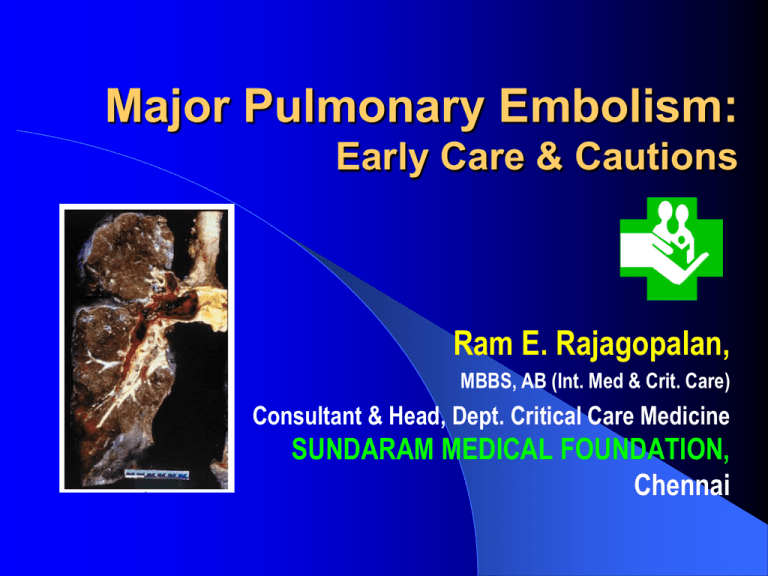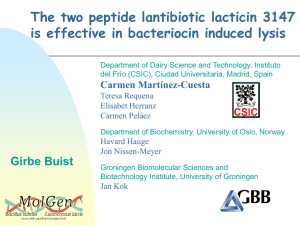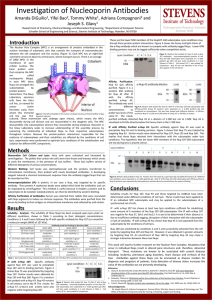
Major Pulmonary Embolism:
Early Care & Cautions
Ram E. Rajagopalan,
MBBS, AB (Int. Med & Crit. Care)
Consultant & Head, Dept. Critical Care Medicine
SUNDARAM MEDICAL FOUNDATION,
Chennai
Goals of this talk
To discuss the acute management
of Major Pulmonary Embolism
with a focus on the pathophysiology of haemodynamic
alterations
Is all PE the same?
Clinical Syndromes:
Dyspnea with or without
pleuritic pain, haemoptysis
~ 90%
Acute syncope,
haemodynamic instability,
shock, arrest
~ 10%
No haemodynamic D
RV dysfunction in 25-40%
Goldhaber et al; Circ 1997
Major PE /
“Haemodynamically
unstable” PE
7 x mortality
Wood, KE. Chest 2002
“Massive” PE; A Misnomer
Clot size is not the only predictor
Mortality
Poor LV
function
Good LV
function
PE Size
Factors influencing survival
399 patients in PIOPED followed for a year
Mortality predicted by:
Underlying Cancer
Prior LV Failure
Underlying COPD
(Carson et al; N Engl J Med 1992.)
Hazard Ratio 3.8
Hazard Ratio 2.7
Hazard Ratio 2.2
Major (High-risk)* PE
Defined as PE with:
Hypotension - SBP < 90 mm Hg
(or K >40 mm Hg)
Cardiac Arrest (PEA)
Mortality (%)
Cardiogenic shock
(organ perfusion defects)
(MAPPET Registry)
Syncope is an underemphasized
feature
* ECS
n=102
n=407
n=316
n=126
The Shock Index
HR (beats/ min)
Shock Index =
SBP (mm Hg)
>1 high risk / <1 low risk
More sensitive & specific
than SBP in predicting
All Death
Fatal PE &
Recurrent fatal PE
RIETE Registry
Eur Respir J 2007; 30: 1111–1116
Shock Index & Mortality
Both the Shock index and SBP were independent predictors of mortality
RIETE Registry
Eur Respir J 2007; 30: 1111–1116
Diagnosis of Major PE
Though Multi-slice
CT Pulmonary Angiography
may be the gold standard of
diagnosis, patients may be
too unstable for the test
Alternative testing?
RV Pressure Load & Failure
(From Wood, KE. Chest 2002)
RV Dimensions
Absolute values irrelevant; error-prone
Compare ratio of RVED to LVED area
in apical 4-chamber view
Moderate dilation
RV: LV >0.6 & <1.0
Normal:
RV:LV area <0.5
Severe dilation
RV:LV >1.0
Change in Septal Kinetics
ECG
LV Pres.
RV Pres.
Septal Kinetics: RVF
RV
LV
Vent Septum
RV
LV
Septal Kinetics; B-mode
Eccentricity Index
RV Dysfunction
ECHO features include:
-Mc Connell sign
-RV dilatation (RV/LV >1)
-Flattening of IV septum
-No phasic collapse of IVC
-Tricuspid regurgitation
Warning: Echo diagnosis
No echocardiographic parameter has
sufficient sensitivity to allow its use
for diagnosis of PE in stable patients
irrespective of severity of symptoms
But, in shock, ……..
ECHO in Major PE
Eur Heart J 2003; 24: 366-76
No patient with
Shock Index >1 &
No RVF on Echo
had PE on CTPA
Haemodynamically Unstable PE
Shock Index >1
2-D Echo
Other causes: AMI, aortic dissection
tamponade, valve
Emboli in PA; in transit
Non
Contributory
Treat: ’Lysis, embolectomy
No PE
In Extremis?
Yes
Major PE: ’Lysis?
Meta-analysis of studies that included major PE:
“Real-world” registry data: ICOPER; 108 major PE (4.5%)
68% got only heparin; 46% mortality (vs. 55% with ’lysis, NS)
& 12% recurrence (vs. 12% after ’lysis)
1. Wan et al, Circulation 2004.
2. Kucher et al, Circulation 2006.
Long-term Effects of ’Lysis
’Lysis
Heparin
RV pressures at 6 months are less than if Rx with heparin alone
Chest. 2009; 136: 1202-10.
Which Agent for ’Lysis?
Alteplase infusions result in best clinical outcomes
100 mg over 2 hours is the recommendation
Capstick & Henry; Eur Resp J 2005
Treatment of Major PE
Risk of bleeding to be considered;
recent surgery, stroke, haemorrhage
Surgical embolectomy
vs.
Catheter embolectomy
Circ 2011; 123: 1788-1830
Cardiac arrest in PE
Patients will present with PEA identified easily
by RV distension (Strongly presumptive)
ECHO during arrest is a valuable tool
Case studies identify improved survival if
thrombolysis is done during CPR
The only controlled trial of ’lysis in CPR
showed no benefit
But AHA/ ERC/ ILCOR recommends lysis
(Alteplase 50 mg) during CPR & continued
compression up to >1 hour
Major PE: Titrating Fluid
Should hypotension in Major PE be
resuscitated with fluid boluses?
“RV Failure”
(From Wood, KE. Chest 2002)
Ventricular Interdependence
With rising RV pressure:
the shared IV septum &
pericardial restraint
influence LV function as well
After Greyson CR;
Crit Care Med 2008; 36: S57–65
Septum “flattens”
LV Dimensions K
LV output declines
Volume Loading?
Physio-illogical! – RV has poor Starling response;
Ventricular interdependence worsens LV function
Mercat et al;
Patients with acute PE
and CI <2.5 L/min
No hypotension
1 bolus; 500 ml dextran
Cardiac index better
RVEDI increases
Crit Care Med 1999; 27: 540-44
Best response with small RV ; use RV size as goal?
Not acceptable in RV shock
Pulse Pressure Variation
45
Pulse pressure
variation during
MV is increasingly
used to judge
“volume
responsiveness”
0
Airway Pressure
120
PPmax
PPmin
70
Arterial Pressure
Pulse Pressure variation
Positive pressure ventilation K venous
return to right heart
-
-
-
-
++
++
A
+ +
+
+
+
+
B
Pulse Pressure Variation
D of RV load
45
has a delayed
(out-of-phase)
effect on LV
“In Series” effect on LV function
0
Airway Pressure
120
PPmax
PPmin
70
RV output
Determines LV preload
Arterial Pressure
& LV output
In-phase variation in RV Failure
From: Vieillard-Baron. Curr Opin Crit Care 2009; 15: 254-60
Pulse pressure variation in RV failure is
a marker of interdependence; not fluid
responsiveness
Classical Observation
AC Guyton
Circ Res 1954; 2:326–332
“Auto-aggravation”
Coronary ischemia
is presumed to be
the final arbiter of
the lethal decline
(From Wood, KE. Chest 2002)
Haemodynamic Support
Avoid excessive
fluid loading
Consider inotropes
Raise systemic vascular pr.
Noradrenaline
____________________________________________________________
Avoid BP drop at intubation
Etomidate for sedation
Dobutamine (with care)
Noradrenaline
Inotropes?
Dobutamine:
Aim; Improving RV contractility
Doses:
<5mg / Kg / min
5-10mg / Kg / min
K PVR and J CO
J HR, no D on PVR
Better than noradrenaline in RVD
Crit Care Med 2007; 35: 2037-50
Hypotension in RV shock patients
Systolic Interdependence:
Isolated heart preparations:
Change in load (pr./ vol.) in one ventricle
alters diastolic & systolic pr. in the other
Acute fluid removal via
VAD
Instantaneous change in
both LV & RV pressures
Not a result of in-series
HD change
Systolic Interdependence:
Magnitude?
RV pressure has a biphasic peak;
one of which coincides with LV pressure
Santamore W;
Chest 1995; 107:1134-45
J RV/LV separation
in a paced, electricallyisolated model allows
mathematical estimation
of LV contribution to RV
systolic function
Systolic Interdependence:
Magnitude?
LV contribution
to LV syst pr.:
95%
15mm Hg
125mm Hg
0
0
75mm Hg
RV contribution
to LV syst pr.:
5%
LV contribution
to RV syst pr.:
65%
15mm Hg
0
0
RV contribution
to RV syst pr.:
35%
Since LV significantly contributes to RV output
Santamore W;
KLV function affects the RV output
Chest 1995; 107:1134-45
Vasoconstriction
A strategy to improve systolic function
Canine model of pulmonary constriction
Coronary blood-flow controlled by roller-pump
Control
PHT
PHT + Aortic Cons
While K coronary flow
coincides with the
deterioration,
the cycle of autoaggravation may
proceed independent
of coronary ischemia
Circulation 1995; 92: 546-554
Aortic constriction K septal shift & J LV output
Allows better right heart pressure generation via
systolic interdependence
Haemodynamic Support
Impaired systolic
interdependence
Raise systemic vascular pr.
Noradrenaline
____________________________________________________________
Avoid BP drop at intubation
Etomidate for sedation
________________________________
Consider inotropes Dobutamine
(with care)
Avoid excessive
fluid loading
Rx Thrombus
’lysis, thrombectomy
Thank you
for your
attention……



![Electrical Safety[]](http://s2.studylib.net/store/data/005402709_1-78da758a33a77d446a45dc5dd76faacd-300x300.png)




